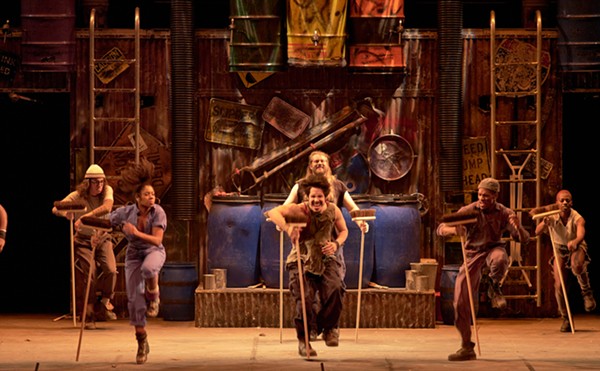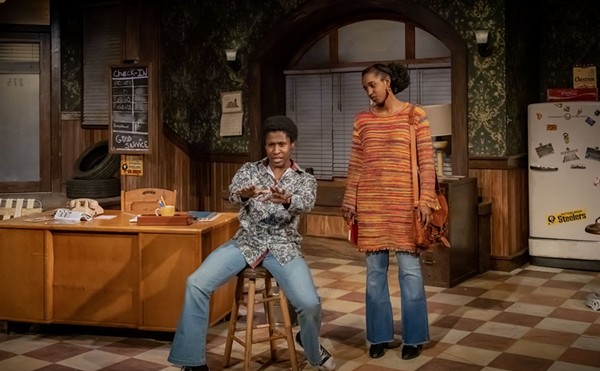Black-and-white portraits, whether drawn, painted or photographed, bring to mind the fugitive quality of human identity, as if the luster of self-awareness, pressed into space day after day, had faded. Such monochromes seem to reproach the extravagance of a world spent in color as they soberly weigh the contradictions of presence and distance.
Most of the paintings, drawings and sculptures by the five artists at the exhibit The Human Subject, curated by Tim Knapp for Cleveland State University, are strikingly, even intrusively personal, like a stranger's face in a mirror, and are devoid of any but the palest traces of color. This is a show, not of ghosts, but of personalities lingering in a ghost world.
There are no weak artists at The Human Subject, but the strongest is probably Susan Hauptman, whose meticulously drawn large-scale charcoal-on-paper self-portraits have become famous over the past two decades and are shown here courtesy of New York's Forum Gallery. They depict an androgynous woman pared down to the human essentials of her physical appearance, like a prisoner or a saint. Her head is always shaved or nearly so, and sometimes she is nude, from the waist down or the waist up; far from being sensual, the partial nudity is always a clinically matter-of-fact, aesthetic decision. In the 2003 "Self Portrait (With Dancers)," Hauptman's perfectly rendered face — indistinguishable from a photographic print — is like a wan sun, rising above a patterned sweater. All of the four drawings here are full-face. Hauptman looks at the viewer with hooded eyes and an enigmatic or sad expression. In "Self Portrait (With Leonard)," (2006), where she is clad in a vintage black gown, her head rests against her husband's plaid patterned shirt. The man (writer Leonard Post) is shown in profile, his hawk-like nose and leftward gaze as solidly horizontal as the beam of a cross. While Hauptman's singular self-portraits are like icons, bulging with a presence barely restrained in two dimensions, this composition is more like a pieta: Hauptman leans in exhaustion against the plaid; the crisscross composition climbs up the picture plane as if prefiguring an Ascension.
In many ways, Clevelander Baila Litton's labor-intensive, six- or eight-foot tall heads are at least as astonishing as Hauptman's more restrained half-lengths. While Hauptman explores the ambiguities of self-image and gender perception and the uses of ultra-realistic depiction to invoke an archetypal realm, Litton accumulates a wealth of graphic detail to build her portraits. Her women of various races and cultures are many times life-size and include fragments of cloth and other materials, collaged onto surfaces stitched together in a grid from multiple sheets of paper. These are homages to the complexity and depth of women's experience, suggesting that a straightforward drawing, no matter how faithful to the subject, needs to be supplemented by a life's worth of other information.
London-based Sean Henry makes bronze sculptures of people dressed in casual, often rumpled street clothes. His figures vary from a little less than half life size, down to about a third, and while they're more colorized than colorful, they fit in well with the overall grisaille of the exhibition, giving an account of human presence that examines the importance of scale to the processes of recognition and identification. Neither toys nor waxwork-style replicas, Henry's sculptures establish their own type of space, like visitors from a smaller world.
Also passing through our perception rather than living among us are the estranged-seeming, displaced figures drawn beautifully in pencil on panel and sealed under a thin, even, sensuous coat of transparent wax by New York-based Jenny Scobel. Scobel's moonlit portraits mix and match heads with a variety of more or less suitable torsos, a little like paper dolls. This aspect of her work is not emphasized at CSU, but if there is no beauty without some strangeness in the proportion, Scobel's figures are beautiful indeed, subtly playing havoc with fixed notions of identity based on race, costume and era.
Misha Kligman emigrated to the U.S. from Kazan, Russia, in 1995, subsequently earning his BA from CSU. Currently the artist lives and works in Kansas City, making paintings and drawings that explore the darkness and wealth of Russian-Jewish heritage. Half-erased by the damage of history, Kligman's small mixed-media work "The Soldier" envisions his ancestry as a coiling root system, a network revealed and obscured in endless underground ramifications. If in our time identity is a lost letter onto which presence is pasted like a postage-due stamp, then Kligman's two small oil-on-panel paintings of passport photos, both with the lower-right corner torn off, sum up the exhibit at CSU: Any version of identity will always be missing a piece.












